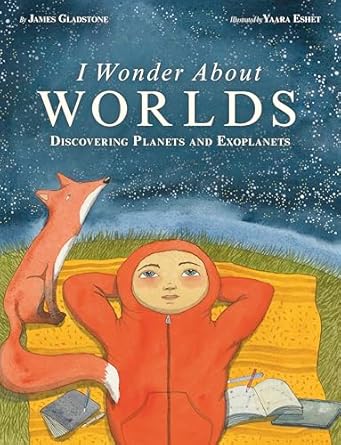I Wonder About Worlds: Discovering Planets and Exoplanets

I Wonder About Worlds: Discovering Planets and Exoplanets
I see a lava world burning fiery hot…
A LAVA WORLD is a type of exoplanet that orbits close to its sun. The temperature is hot on these rocky orbs. Scientists think that a world like this would be partly covered in a red-hot lava ocean.
Fantasy, curiosity, and a large portion of facts combine in I Wonder About Worlds: Discovering Planets and Exoplanets. Award-winning author James Gladstone has created a story of a child who looks up at the stars and wonders. Unlike many of us who might head to a library or computer to investigate the night sky, the child in this story heads off in a space ship through the Milky Way to investigate in person what is hidden even to our deep-space probes. Along for the ride is an equally curious fox.
Illustrator Yaara Eshet has created the perfect adventuring duo. The genderless child and the curious fox appear filled with wonder as they journey through space to exoplanets.
Planets outside of our solar system are called EXOPLANETS. They orbit other suns in our galaxy. Astronomers have found thousands of exoplanets, but they think there are billions just waiting to be discovered!
The story begins with the child and fox heading outside in the company of an adult just as night begins to fall. Using a telescope, they view the closer planets in our solar system and then look at pictures of the farthest planets sent back by deep-space probes. But eventually, what we can see from earth isn’t enough.
Some worlds are so far away, we can’t see what they look like at all. So I rocket through the Milky Way — a nighttime river of daylight stars …
The facts in the sidebar explain more about the Milky Way.
Our solar system is part of the MILKY WAY galaxy. We call it the Milky Way because it looks milky white in our night sky.
The Milky Way is a spiral galaxy. We can see only part of our galaxy from Earth because we are inside of it. If we could travel far outside of the Milky Way, we could see its whole spiral shape.
The Sun is one star in the Milky Way. There are billions of other stars in our galaxy. And trillions of other galaxies fill the whole universe.
The text and illustrations combine to present complex concepts that may be unfamiliar to young readers as our young adventurer and companion explore lava worlds and water worlds and eventually find a rocky world.
Earth lies in the habitable zone of our solar system. It is the only world we know of — so far! — that has life.
Astronomers think there may be millions, or perhaps billions, of rocky exoplanets in habitable zones. Is there life on one of these worlds? And could life exist on worlds that are not in habitable zones? Only time and careful study will tell
I Wonder About Worlds: Discovering Planets and Exoplanets is an imaginative look at a very complex topic.
Suzanne Pierson is a retired teacher librarian and library course instructor who tends her Little Free Library in Prince Edward County, Ontario, for the enjoyment of her friends and neighbours of all ages.
